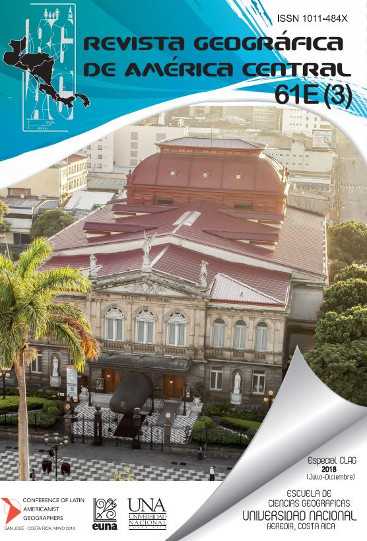What does the future hold? Historical climate analysis and projection of future climatic scenarios for the andean canton of Pedro Moncayo, Ecuador
DOI:
https://doi.org/10.15359/rgac.61-3.15Keywords:
climate change, historical variability, scales, Ecuador.Abstract
The natural and anthropogenic variations of climate systems are increasingly evident. Climate change has become the central theme of research for decision making at all levels. The principal objective of the current research is to identify the evidence of change in certain climatic elements, such as precipitation and temperature at the local scale in Pedro Moncayo, Ecuador. The study uses records from 1981-2017 produced by 126 meteorological stations of the National Institute of Meteorology and Hydrology closest to the study area. Geographical Information Systems were used for statistical analysis and geographical representation. This is the first study that presents climate scenarios at local scale in Ecuador, It aims to be a contribution for the scientific community, but especially for vulnerable communities in their planning processes and strengthening their adaptation capacity.
References
Arnell, N., Tompkins, E., & Adger, W. (2004). Elicting information on the likelihood of rapid climate change. Conference on Perspectives on Dangerous Climate Change . United Kingdom.
Arteaga, A., Cáceres-Arteaga, N., & Cáceres, L. (2017). El Acuerdo de Paris sobre Cambio Climático. Ambición, Credibilidad y Factibilidad. Arje Revista de Posgrado FaCE-UC, 304-313.
Berrang-Ford, L., Pearce, T., & Ford, J. (2015). Systematic review approaches for climate change adaptation Research. Regional Environmental Change, 755-769.
Burke, M., Dykema, J., Lobell, D., & Satyanath, S. (2015). Incorporating climate uncertainty into estimates of climata change impacts. Review of Economics and Statistics, 461-471.
Climate Hazard Group. (18 de February de 2018). Data Tools. Obtenido de http://chg.geog.ucsb.edu/about/index.html
Conference of the Parties. (2015). Adoption of the Paris Agreement. Paris.
G Wagner, M. W. (2015). Climate chock. The economics consequences of a hotter planet. New Jersey: Princeton University Press.
Gobierno Autónomo Descentralizado de Pedro Moncayo. (2015). Plan de Ordenamieno y Desarrollo Cantonal del Cantón Pedro Moncayo, Actualización 2015-2025. Tabacundo.
Intergovernmental Panel on Climate Change - IPCC. (2012). Managing the Risks of Extreme Events and Disasters to Advance Climate Change Adaptation. Cambridge and New York: Cambridge University Press.
Intergubernamental Panel on Climate Change - IPCC. (2008). Report of the 28th Sessión of the IPCC. Budapest.
Intergubernamental Panel on Climate Change - IPCC. (2014). Climate Change 2014: Synthesis Report. Contribution of Working Groups I, II and III to the Fifth Assessment Report of the. Geneva.
Meinshausen, M., Meinshausen, N., Hare, W., Raper, S., Frieler, K., Knutti, R., & Allen, M. (2009). Greenhouse-gas emission targets for limiting global warming to 2ºC. Nature, 1158-1163.
Ministerio del Ambiente - MAE. (2014). Acuerdo Ministerial No. 137. Quito.
Ministerio del Ambiente - MAE. (2017). National Communication on Climate Change. Quito.
Nuñez, R. (2016). Asset for health: linking vulnerability, resilience and adaptation to climate change. Warwick: Tyndal Centre for Climate Change Research.
Roy, S. S. (2018). Linking Gender to Climate Change Impactos in the Global South. Coral Gables: Springer.
Smit, B., Burton, I., Klein, R., & Wandel, J. (2000). An Anatomy of Adaptation to Climate Change and Variability. In Y. G. Kane S.M., Societal Adaptation to Climate Variability and Change (págs. 223-251). Dordrecht: Springer.
Stern, N. (2008). The economics of climate change. American Economic Review, 1-37.
United Nations Framework Convention on Climate Change - UNFCCC. (1992). United Nations Conference on Environment and Development - UNCED. Rio de Janeiro.
United Nations Framework Convention on Climate Change - UNFCCC. (2015). Paris Agreement. Bonn: UNFCCC.
Wagner, G. &. (2015). Climate shock. The economics consequences of a hotter planet. New Jersey: Princeton University Press.
Downloads
Published
How to Cite
Issue
Section
License
Proposed policy for journals offering Open Access
Authors publishing their works in the Journal acknowledge and agree to the following terms:
a) Authors retain the copyrights to their works and guarantee the Journal the right to be the first to publish their works, under the Creative Commons License Attribution-NonCommercial-ShareAlike 4.0 International, CC BY-NC-SA 4.0 International (https://creativecommons.org/licenses/by-nc-sa/4.0/deed.es), which allows others to share works upon complying with the acknowledgment of authorship and mention of the Journal as the original publisher of the work.
b) Authors are permitted to separately establish additional agreements for the non-exclusive distribution of the official edition of the work published in the Journal (for example, authors may desire to place the work in an institutional repository or incorporate it into a book that is to published elsewhere) so long they acknowledgment to recognize the Journal as the original publisher. The aforementioned additional agreements must respect the terms of the non-profit character and sharing philosophy of the original license (CC BY-NC-SA 4.0 International, https://creativecommons.org/licenses/by-nc-sa/4.0/deed.es).
c) Authors are encouraged to archive the post-print or editor/PDF version in Open Access repositories.






 REVGEO is licensed under https://creativecommons.org/licenses/by-nc-sa/4.0/deed.es
REVGEO is licensed under https://creativecommons.org/licenses/by-nc-sa/4.0/deed.es
.svg_4.png)

_(1).png)
_(1)_(1)_(1)_1.png)
(2)(1)(1)(1).png)
